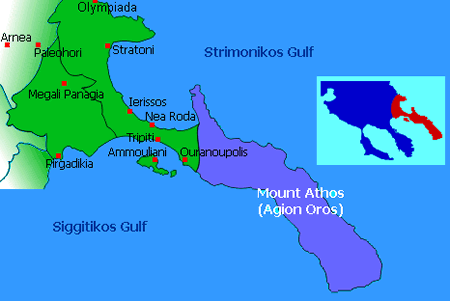 |
| Mount Athos |
Christian monasticism began in the eastern Christian world when St. Antony of Egypt, who exemplified the solitary form of monastic life, entered the Egyptian desert in the late third century c.e. Soon afterwards, Pachomius of Egypt and the Desert Fathers developed the communal life.
From here, early monasticism spread to Palestine, Syria, and the West. Monasticism’s birthplace was vastly affected by the Islamic conquests of the seventh and eighth centuries and declined in its wider historical significance. The heart of (Chalcedonian) Orthodox monasticism is Mt. Athos in northern Greece, on a rugged peninsula extending 35 miles into the Aegean Sea.
It is the easternmost of three such “fingers” that stretch out from the Chalkidike Peninsula. The name of this promontory is derived from its highest peak, the nearly 7,000-foot Mount Athos. The Orthodox refer to this region as the “Holy Mountain” because of its spiritual significance over the past millennium.
  |
In the eighth and ninth centuries monks journeyed to Mount Athos to find refuge during the controversy of Iconoclasm when the state forbade icon veneration. By the later ninth century c.e. the area was already becoming known for its reputation for holiness. In 963 c.e. the monk Athanasios of Trebizond created the first communal monastery there, the Great Lavra.
Several Byzantine emperors supported Athanasios, endowing the monastery with wealth, privileges, and land. Other monasteries quickly followed. In less than 40 years, there were almost 50 monasteries, with the hegoumenos (abbot or presiding father) of the Great Lavra holding the preeminent position. Mount Athos sprouted communal monasteries as well as sketes, small groups of monks who lived separately from a general community but came together for worship and feast days.
Mount Athos was also home to many anchorites, or hermits. Monastic life, in all its variety, blossomed on Athos, but it did so with strict gender separation, for, in 1045 c.e., the emperor banned all females and even female animals. Women were, and still are, excluded both as members and even as visitors.
Patronage continued from Byzantine emperors as well as from Slavic rulers in Serbia, Bulgaria, and Russia. Mt. Athos became a truly international community where monks from all over the Orthodox world mingled together: Italians, Greeks, Georgians (Iveron Monastery), Russians (Panteleimon), Serbs (Chilandar), Bulgarians (Zographou), and Orthodox Armenians.
Theological ideas quickly passed, via Mount Athos, from one part of the Orthodox world to another. Such was the case in the 14th century when the controversy over Hesychasm (the “Jesus Prayer”) led to its defense by Athonite Gregory Palamas and its spread throughout Orthodoxy.
Its accumulated wealth made the peninsula attractive to invaders. In the 13th century Athos fell into the hands of western European crusaders and, after the 14th century, to the Ottoman Turks, who, after accepting tribute and depriving the monasteries of their estates outside, respected the autonomy of the region.
   |
While Mount Athos was the heart of Orthodox monasticism, it was not the only center of monastic life—many other areas, Meteora in central Greece, for example, were well known. Monasteries (ranging in size from a few monks to hundreds) sprouted up wherever there were Orthodox communities.
So, not surprisingly, when the town of Mystras, located west of ancient Sparta, became an important Byzantine cultural and political center in the 13th–15th centuries c.e., monasteries (like the Brontocheion) appeared as well. Unlike Athos, however, this region lost its wider importance after the Ottoman conquest of 1460 c.e.
